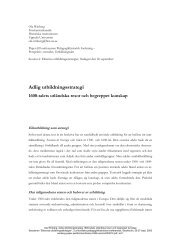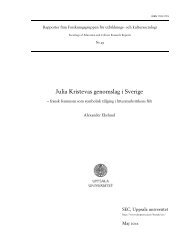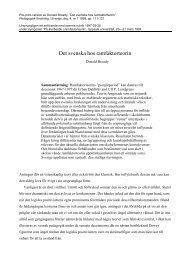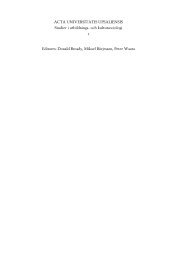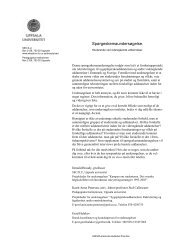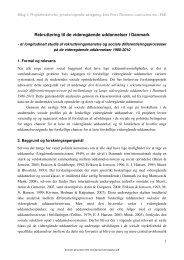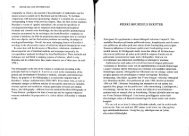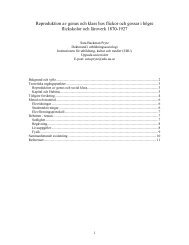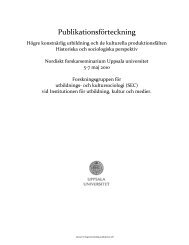exploring uses of digital archives in research and ... - skeptron.uu.se
exploring uses of digital archives in research and ... - skeptron.uu.se
exploring uses of digital archives in research and ... - skeptron.uu.se
You also want an ePaper? Increase the reach of your titles
YUMPU automatically turns print PDFs into web optimized ePapers that Google loves.
their learn<strong>in</strong>g or how they might be reflect<strong>in</strong>g on the content by us<strong>in</strong>g a portfolio. The shiftfrom proprietary teach<strong>in</strong>g materials <strong>and</strong> tools to a Web ba<strong>se</strong>d <strong>and</strong> multipurpo<strong>se</strong> usage <strong>of</strong>different k<strong>in</strong>ds <strong>of</strong> resources, such as a <strong>digital</strong> archive, is, however, to the purpo<strong>se</strong>. Forexample, the notion <strong>of</strong> “resource-ba<strong>se</strong>d teach<strong>in</strong>g” might be u<strong>se</strong>ful to elaborate s<strong>in</strong>ce it<strong>se</strong>ems to signify a convergence <strong>of</strong> pedagogy <strong>and</strong> <strong>re<strong>se</strong>arch</strong>, by <strong>of</strong>fer<strong>in</strong>g solutions whereresources might be <strong>se</strong>parated from their manifold <strong>and</strong> <strong>in</strong>volves highly changeable <strong>u<strong>se</strong>s</strong>. 38On the relation between <strong>re<strong>se</strong>arch</strong> <strong>and</strong> educational practices – scholarly <strong>u<strong>se</strong>s</strong><strong>of</strong> <strong>digital</strong> <strong>archives</strong>Above I have argued that there is a need for <strong>archives</strong> <strong>of</strong> content modules on the web - easyto share, to navigate, <strong>and</strong> to comb<strong>in</strong>e <strong>and</strong> reu<strong>se</strong> <strong>in</strong> new contexts. If such <strong>archives</strong> are to bebeneficial <strong>in</strong> various educational <strong>se</strong>tt<strong>in</strong>gs, <strong>and</strong> if they are to stimulate freedom <strong>of</strong> choice <strong>in</strong>higher education, it is crucial that the content is adapted to emerg<strong>in</strong>g <strong>in</strong>ternationalagreements <strong>and</strong> st<strong>and</strong>ards on mark-up languages <strong>and</strong> metadata. El<strong>se</strong>, the content will belocked <strong>in</strong>to proprietary platforms <strong>and</strong> applications. My aim is therefore grounded <strong>in</strong> ast<strong>and</strong>po<strong>in</strong>t on the benefits <strong>of</strong> multiple <strong>u<strong>se</strong>s</strong> <strong>of</strong> <strong>digital</strong> content <strong>and</strong> flexible content design, <strong>of</strong>e.g. orig<strong>in</strong>al sources <strong>and</strong> <strong>re<strong>se</strong>arch</strong> material <strong>in</strong> higher education, as an important alternativeto teach<strong>in</strong>g materials which are predef<strong>in</strong>ed <strong>and</strong> predest<strong>in</strong>ed for specific cour<strong>se</strong>s orsituations. Then, the question here is; how might teachers <strong>and</strong> students benefit fromemerg<strong>in</strong>g mark-up <strong>and</strong> metadata recommendations <strong>and</strong> st<strong>and</strong>ards?My st<strong>and</strong>po<strong>in</strong>t <strong>in</strong>corporates an notion <strong>of</strong> student learn<strong>in</strong>g <strong>and</strong> work<strong>in</strong>g which is more alike<strong>re<strong>se</strong>arch</strong>. 39 That is: to provide opportunities for students to f<strong>in</strong>d “[...] a clo<strong>se</strong>rapproximation <strong>of</strong> the th<strong>in</strong>g it<strong>se</strong>lf” 40 . While confront<strong>in</strong>g a wholly or partially unknown“body <strong>of</strong> knowledge” 41 is a challenge <strong>in</strong> reality for many teachers <strong>and</strong> <strong>re<strong>se</strong>arch</strong>ers, thesituation is opposite for many students <strong>in</strong> higher education, a challenge which is effectivelyavoided by an extensive emphasis on syllabi. I want to emphasize that I am not advocat<strong>in</strong>ga “teacher-less education” or someth<strong>in</strong>g alike. On the contrary, the teacher’s role should bestrengthened by giv<strong>in</strong>g opportunities to teach <strong>in</strong> a context rem<strong>in</strong>d<strong>in</strong>g <strong>of</strong> <strong>re<strong>se</strong>arch</strong> work. Theteacher might provide judicious po<strong>in</strong>ts <strong>of</strong> departure, suggest possible strategies, <strong>and</strong> guidestudents <strong>in</strong> their exploration <strong>of</strong> content <strong>and</strong> materials.In a situation when educational systems <strong>and</strong> resources proliferate, the need forst<strong>and</strong>ardization becomes apparent. Like <strong>in</strong> any st<strong>and</strong>ard driven <strong>in</strong>itiatives, st<strong>and</strong>ardizationapplied to educational <strong>se</strong>tt<strong>in</strong>gs <strong>and</strong> <strong>re<strong>se</strong>arch</strong> is focu<strong>se</strong>d towards enabl<strong>in</strong>g, reus<strong>in</strong>g <strong>and</strong><strong>in</strong>teroperability among heterogeneous computer platforms <strong>and</strong> s<strong>of</strong>tware systems. Toachieve this, con<strong>se</strong>nsus is needed on a number <strong>of</strong> issues e.g. architectures, <strong>se</strong>rvices,protocols, data models, classification schemes <strong>and</strong> <strong>in</strong>teroperability between differentst<strong>and</strong>ards - whether they are de facto or established by the ISO st<strong>and</strong>ardisationorganisation. This is an active, cont<strong>in</strong>uously evolv<strong>in</strong>g process that will last for years tocome <strong>and</strong> a complex process, which occurs at <strong>se</strong>veral levels <strong>and</strong> is supported by manydifferent related <strong>and</strong> st<strong>and</strong>alone <strong>in</strong>itiatives.Among the most important general st<strong>and</strong>ardization efforts when it comes to mark-uplanguages <strong>and</strong> metadata, which has to <strong>se</strong>rve as the prerequisite for <strong>re<strong>se</strong>arch</strong> <strong>and</strong> educationalpractices described <strong>in</strong> this paper, are SGML (St<strong>and</strong>ard Generalized Markup Language, ISO38 See e.g. Chambers, 2000, Spaeth & Cameron, 2000.39 Cf. Broady, 1995; 1997; 2001, Bourdieu 1996a&b, Illich, 1970 & Fl<strong>and</strong>ers, 2002. Although <strong>in</strong>spiration hasbeen ga<strong>in</strong>ed through read<strong>in</strong>gs <strong>of</strong> disparate texts <strong>and</strong> authors I here foc<strong>u<strong>se</strong>s</strong> discussions on the usage <strong>of</strong> contentor teach<strong>in</strong>g material although the issue is somewhat differently argued <strong>and</strong> discus<strong>se</strong>d40 Fl<strong>and</strong>ers, 2002:50.41 Ibid.pm-030505.doc utkast avh.pm. Monica Langerth Zetterman 9(34)



